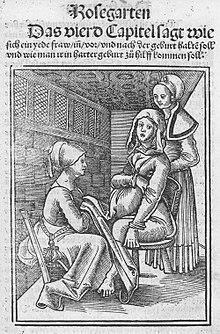Birthing chair



A birthing chair , also called "birthing chair" or "Gebärschemel" is a special seating that women should facilitate the birth. For a long time it was part of the basic equipment of midwives .
history
At all times and in all parts of the world, women have tried to relax by adopting different postures during childbirth, and have used different aids to do this. The upright posture of the upper body was usually preferred and supported, as this allows the use of gravity. The seating options chosen range from suitable stones and stools to lavishly constructed special furniture with art historical significance or current patent value.
Female figurines in Çatalhöyük
In the Neolithic settlement Çatalhöyük , the "mother goddess" is the most famous example of the figurines found there. It is from 5750 BC. And can be seen in the Museum of Anatolian Civilizations in Ankara . Since she is sitting on a stately chair giving birth, this could be regarded as the earliest documented birthing chair.
Birth chair among the Egyptians
In Egypt there were already around 2500 BC Chr. Birth chairs. An almost 4,000 year old specimen of a magical birth brick was unearthed by American archaeologists in 2001 in Abydos, Egypt . Depictions of wooden birthing stools can often be found in the reliefs on the walls of the Mammisi (birth shrines) of the late and Roman times. The wall of the outer temple circumference of Kom Ombo (40 km north of Aswan ), which shows the "instrument cabinet", the extensive range of instruments available to an Egyptian doctor , also dates from this time . To the left of this cupboard are two female figures sitting on birthing stools; the lower figure can be identified as the Mother of God Isis by the throne on her head.
The Bible mentions the existence of birthstones for the period of bondage of the Israelites in Egypt (approx. Second half of the 2nd millennium BC). Whether this is historically reliable information from this time is disputed, since the biblical texts are in any case considerably younger than the epoch described. In the second book of Moses , a new pharaoh, who no longer knew anything of the great merits of Joseph , horrified before the sharp increase in the number of Israelites in his land. He fears that they might rise up against him. So he orders the two Hebrew midwives Shifra and Pua: “ If you give birth to the Hebrew women and see on the two stones that there is a son, kill him; but if it is a daughter, she should live! “(Usual translation: Ex 1.16 EU ).
Here in the Hebrew Bible is the term אָבְנָי steht, that is the dual of stone, so it means double stone . Most German Bible translations do not reproduce the term exactly, but rather circumscribe it or omit it entirely. The name obviously points to an archaic piece of seating furniture, which, like the Egyptian natal bricks, consisted of two stones (bricks) and left space in between for the child to exit the womb.
The two midwives reply after the Pharaoh calls them over for not obeying his command: “ The Hebrew women are not like the Egyptian women. They are like animals, even before the midwife comes to them they have given birth ”( Ex 1.19 EU ). Whether it can be concluded from this obvious protective claim that birth chairs were not common among the Hebrew women at this time, i.e. that it was a genuine Egyptian piece of furniture, is questionable.
Birth chairs in the Middle Ages and modern times
The birth on a birthing chair comes very close to the natural squatting position at birth, as it is in primitive peoples, e.g. B. Africa, is known from many sources. In those countries and periods of time in which it was not common to crouch on the floor for hours at work, eating, talking, etc., this posture would not have relaxed the muscles of the woman giving birth. A wide variety of designs for seating furniture were therefore conceived and communicated with the advent of the art of printing.
Because of the lack of effective contraceptives and the strong religious and social reservations about abortion , most women used to be one pregnancy after another. A childbirth chair was therefore often part of the basic equipment of a midwife or a wealthy woman in ancient times. Such pieces of furniture were not only soberly functional, but often artistically designed.
The beds and chairs offered in the delivery room today are easy-care and comfortable constructions with motorized adjustable sections and supports (possibly even swiveling with the woman giving birth, as in the case of the Romarad ), which allow great variability in posture during birth. Thus, on the one hand, gravity can be used during the birth process and, on the other hand, it is easier for the midwife or doctor to see and access the birth canal .
Web links
- Comprehensive (but not always 100% correct) overview work on the subject of childbirth and birthing furniture ( PDF )
- Article by Wolfgang Regal / Michael Nanut, Doctors Week 21/2007 [1]
- Birth chair and ancient Egyptian birth scene [2]
- Report on the discovery of the Egyptian birthing chair (English, p. 35), PDF

